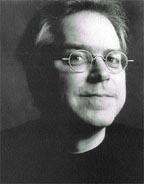
(Bill Frisell)
Bill Frisell took the chapel stage with bassist Tony Cherr and drummer Kenny Wollesen last Saturday, Feb. 2, and shared with the audience examples of his original contributions to the world of music. A distinction between the “world of music” and the “world of jazz” should be made clear by the fact that, while Frisell is commonly thought of as a jazz artist, his musical interests go far beyond that.Frisell draws his influences from many other styles of music besides jazz. His concept on guitar tone draws enormous influence from the styles of country/western and folk music. But Frisell is not one to limit himself to just one sound. He incorporates aspects of traditional jazz, rock, and sounds which have yet to be categorized (something which is not at all necessary).
From the opening tune, Frisell presented many of his sounds in a free, spacious introduction. He utilized several pedals and a sampler to record many different sounds and phrases, and overlapped them to create more density in the ensemble. The trio then settled into a soft groove with a folk/country tinge, at times almost resembling surf music.
After a short transition by Frisell, the next tune was a freer feeling groove with a nice, simple melody over the top. Once again using his sampler, Frisell added some very interesting tonal colors on top of the melody before kicking it into a harder, distorted jam that faded into a mesh of sound created by the sampler.
Frisell continued to improvise, transitioning into the next tune as the trio settled on a laid back folk feel with solos by Frisell and Scherr.
This ended the trio’s first lengthy set of pieces, and was the first time the audience was able to give their full applause. During the entire first set, Frisell never made eye contact with the audience, his attention devoted entirely to the music. This could be perceived by some as disrespect, or a pretentious act of pseudo-depth. But from the perspective of this reviewer, it seemed to be more of an act of shyness. This supposition was further proved after the show, when he met members of the audience. He was responsive and not at all self-complacent, but also very quiet and reserved.
Frisell opened his second set of tunes with an intro that moved into a smooth and light groove in which he sampled himself and then improvised over it. This led into a slower feel in which Frisell created all kinds of avant-garde, overlapping sounds. This piece was the most interesting part of the performance, as all of the previous pieces had been well coordinated to the point of near stagnancy. Frisell kicked it up a notch in this tune by adding distortion to his sound and getting more intense. He lead into a nasty solo, and his band was right there behind him with a solid groove that did not seem to land in the most obvious places.
An ethereal guitar transition followed, going into a slower, steady feel reminiscent of the music that had already been played. Frisell’s style was especially prevalent on his solo in this piece, utilizing a lot of space and simple ideas as foundations for a stronger sound.
The trio then moved into the standard “Moon River.” After the guitar and bass solos, the drummer soloed for the first time in a musical conversation with Frisell. Frisell took little time in starting the next tune by sampling layers of his guitar sound, then embarked on a more bluesy solo with interjections consisting of washes of sound created by his pedals and samplers over the relaxed groove. The trio gradually faded out, leaving only Frisell and the samples he had made throughout the tune, which at times sounded like a small orchestra.
Frisell closed the evening by soloing over the samples he created, and as the trios faded out, ended the concert. The Bill Frisell Trio gave an original performance in which they were not afraid to let the music they heard in their heads come out in their playing.
